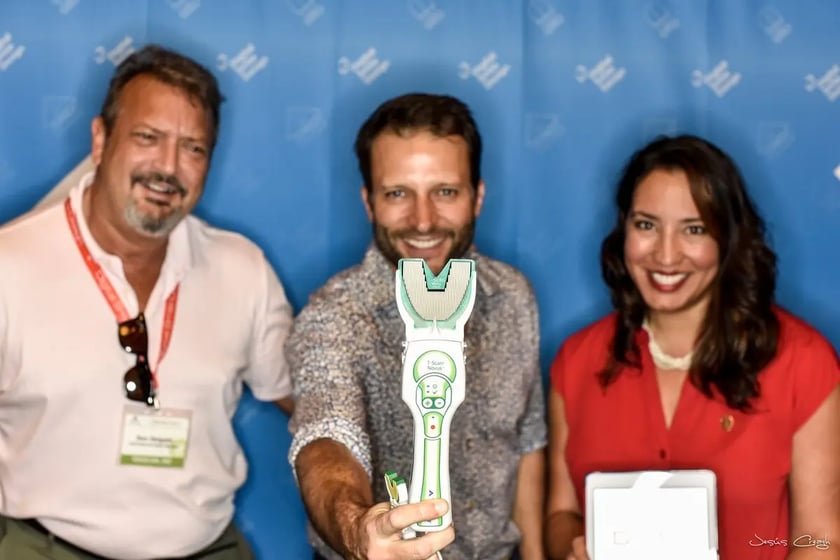Everything you need to know about digital occlusal planning
.png?width=2161&name=Header_3%20(1).png)
T-Scan by Tekscan is an innovation in scanning and digital dentistry that is transforming bite scanning and treatment planning in dental clinics across the world. It’s a very useful and powerful piece of bite scan technology for identifying occlusal issues. This technology works in conjunction with the occlusal paper; it’s not a substitute but adds a lot of value to the existing technology and can be utilized at every stage of the patient journey.
Why do we need to use T-Scan as well as occlusal paper?
When we use occlusal paper to identify the occlusal points, there are two common issues:
- The occlusal paper cannot identify the differing strengths: from all the spots it cannot identify which one is the strongest, and sometimes the biggest one isn’t necessarily the strongest.
- The occlusal paper cannot identify the timeline: which contact is first. As dentists, we can end up adjusting the wrong contact because we may have a contact that is very small on the occlusal paper but that is actually first interference. This smaller contact can actually be what is pushing the jaw to shift a little bit to hit all the other contacts.
With the utilisation of T-Scan technology we can identify the load distribution of each contact and understand the timeline, to know which contact comes first. The result is being able to create a strategy of diagnosis, planning and adjustment. It can also be used on maximising spatial context or on the exclusive movements, to register the movements of teeth and understand where teeth are moving in protrusion, guidance and lateral movements.
How can you use T-Scan in the dental office?
T-Scan technology can be used at all stages of the patient journey, from the first visit all the way through to completion of treatment and maintenance.
The First Appointment
In the first appointment, patients generally fall into one of three categories:
- Prevention case - here the patient has a perfect mouth and everything is stable. All that the patient needs is prevention and maintenance through education and hygiene sessions.
- Localised disciplinary dentistry case - this is where the patient needs a localised intervention, with a specific tooth or area of concern.
- Comprehensive case - when the patient needs a comprehensive treatment plan, either because of smile design or the patient needs intensive dentistry to repair and restore the smile.
For all patients, T-Scan can be used in the first appointment to help understand the patient’s smile better, to see what is working well and identify any issues. It can enable us as dentists to diagnose any occlusal or functional problems from the start. It is also a great tool in the first appointment to communicate with the patient, to educate and visually motivate the patient to address any issues that may have been found during the examination.

The Comprehensive Case
The opportunity to use T-Scan extends beyond the first appointment. When treating a comprehensive case, it can be used at the second appointment to motivate and educate the patient about why treatment plan is necessary. This may not necessarily mean using it in the patient’s mouth again, but by referring back to the files that were recorded at the first appointment you can clearly illustrate the treatment plan and the desired result. This can help to increase case acceptance.
Once the patient has accepted the treatment plan, and the case has moved into the treatment phase, this can be divided into three distinct moments:
- Preparatory Moment
- Complimentary Moment
- Final Restorative Moment
Preparatory Moment
This moment is about addressing any emergency treatment and also taking care of the patient holistically. Bite and posture are linked so it is possible to actually improve the whole body’s equilibration by treating the mouth. Dr Robert Coachman from the Well Clinic in São Paulo, was a pioneer in working with chiropractors to see the difference that could be made at this early stage.
After this moment, the dentist may look further into bite deprogramming, opening the vertical dimension and understanding the ideal bite for the patient’s rehabilitation.
Complimentary Moment
At the end of the first moment, the patient will usually end up with transitional restorations to test the new bite. This is an opportunity to use T-Scan again to check the transitional restorations after building the new bite position to fine-tune the new smile. Once this is set, the patient may be treated by other specialists, such as orthodontists or periodontists, to achieve their beautiful, perfect smile.
Final Restorative Moment
One of the main reasons that Digital Smile Design restorations fail is a lack of fine-tuning after cementation. It is vital to develop a precise protocol of bite equilibration after bite rehabilitation. This is an entirely separate step to cementation. Although we endeavour to get the bite right in the first moment, it is in the second moment that we can fine-tune and address any issues. This happens a few days after the cementation. This is because the patient is often tired after the restoration and their posture may not be ideal. This moment is ideally completed first thing in the morning, when the patient and dentist are both fresh. Occlusal papers and T-Scan technology can be utilized to check and identify any interferences in the Digital Smile Design result.
The maintenance phase
Once treatment is complete, at every hygiene session T-Scan can be used to evaluate the smile and bite. Hygienists in clinics can be trained to complete this process and understand when to raise a yellow or red flag to dentists by analysing the data. This allows dentists to stay one step ahead of issues before they develop into a bigger problem.
Watch the technology in action
For a closer, more in depth look at how T-Scan technology can be utilized for digital dentistry in your dental clinic, watch this short video from DSD founder and CEO Christian Coachman, demonstrating the use of this innovative piece of bite technology:
Are you frustrated by the limitations of using bite registration material?
The DSD Residency program is designed to introduce dentists to digital workflows that will skyrocket accuracy and efficiency, incorporating technology that improves communication with your patients. Find your course here:


